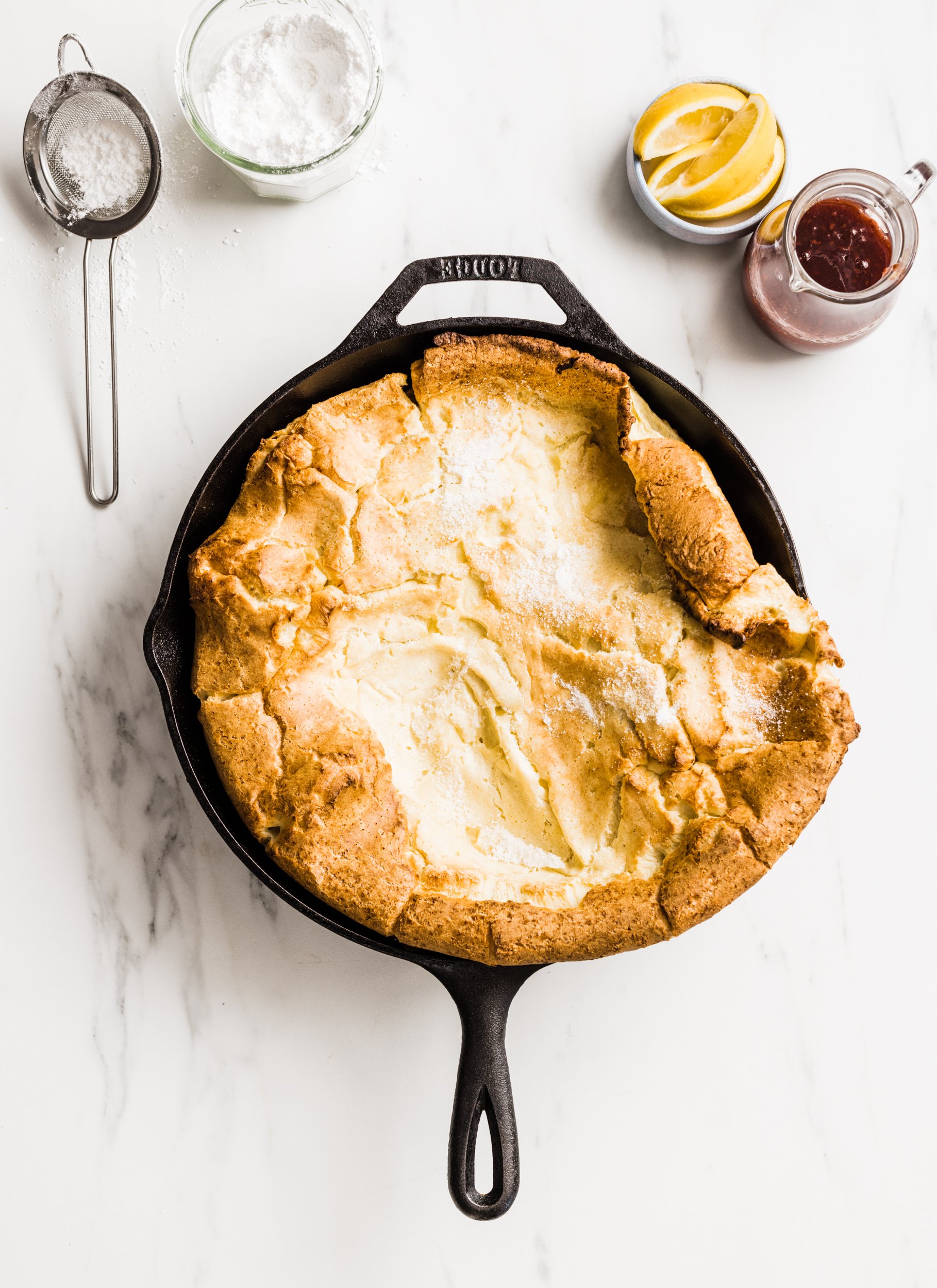Triple Dutch
Photos by Michael Piazza / Styled by Catrine Kelty
German pancake, pannekoeken, Dutch baby, call it what you like*, but there’s no debate: These puffy pancakes are a surefire crowd-pleaser. Best of all, they are ridiculously simple to prepare—just stir together a batter of flour, egg and milk, dump it into a hot buttered skillet and bake away. What you get after 20 minutes or so is a ridged-and-folded zeppelin of a baked good, with a golden-brown, popover-like exterior and a tender, custardy interior. Like soufflés, even the best Dutch babies contract a little upon cooling, which is just physics, but there’s more than enough time to get them on the table before that happens, and a good one will still be delicious after the inevitable collapse.
The classic Dutch baby, topped with a squirt of lemon juice and a snowfall of powdered sugar, or maybe some butter-softened apple wedges, is meant as a breakfast or dessert treat, but the basic structure can lean savory just as easily as sweet, making it a versatile choice for dinner, dessert or brunch. And savory ones make for a satisfying, quick-to-throw-together meal, whether or not you have guests coming by.
I have made my share of Dutch babies over the years, and I’ve had my share of those that refused to puff up. But, after a lot of experimentation, I’ve sorted out why that sometimes happens—and how to avoid it. There are a lot of opinions on how to foolproof a Dutch baby, but most of them turn out to be nothing more than hot air (in my humble opinion). Here are the three things I’ve found that really matter:
One: Let the batter rest before pouring it into the skillet, which helps to shore up the gluten it contains, so it can balloon maximally. A Dutch baby inflates thanks to water in the batter converting to steam in the oven; as in bread, it’s the gluten that serves as the “walls” of the balloon. It doesn’t need to rest very long, only about as much time as it takes for the oven to come to temperature (which is why I mix the batter before turning it on).
Two: Preheat the skillet, and get it good and hot, to ensure that enough of the water in the batter turns to steam before the whole thing starts to set. To do this, I just place the skillet in the oven before turning it on, so they heat up together. (And while you can make a Dutch baby in any heatproof nonstick skillet, cast iron works best, since its extra mass holds onto a lot of heat.)
And three: Don’t stir too much of anything into the batter that can interfere with gluten development and structure. When I was testing my black pepper–Parmigiano version, anytime I whisked the cheese into the batter, I ended up with a frisbee rather than a balloon. When I switched to sprinkling it over the batter in the skillet, the puff returned. As long as you follow those simple guidelines, I promise your Dutch baby will inflate.
Of course, the batter recipe matters too, but that has less bearing on whether or not it puffs as it does the texture and the shape of the baked pancake. Too much flour or not enough milk, and you end up with something dry and overly crisp; too little flour or too much milk, you get something soft that doesn’t stay aloft as it starts to cool. Too much egg, and you end up with something that is, well, eggy—more omelet than pancake. The ratio I landed on gives you a pancake that is just right, with a custardy, moist core and a tall, crisp (but still tender) shell.
As for the recipes: I’ve tried to create examples of sweet and savory Dutch babies that are excellent just as they are, but also can serve as useful templates for others. The berry-topped one has almond extract in the batter and sliced almonds on the pancake and as a garnish, along with a mascarpone whipped cream to serve with it. The savory one is flavored with black pepper and grated Parmigiano-Reggiano, and gets topped with a cherry tomato, arugula and Parmigiano salad. Finally, there is a simple sweet one, topped with powdered sugar and a drizzle of thinned out berry jam. Hopefully all of these set the wheels in motion for creating your own Dutch babies.
*Despite what it suggests, Dutch baby is the American name for a dish that originated in Germany. The name Dutch baby was applied to it by an American restaurant owner who dropped a few letters from Deutsch, the German word for German. (The “baby” was there because his restaurant made mini ones.) Because Dutch baby is an American term, that’s the one I use.




